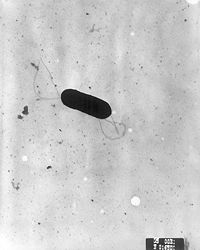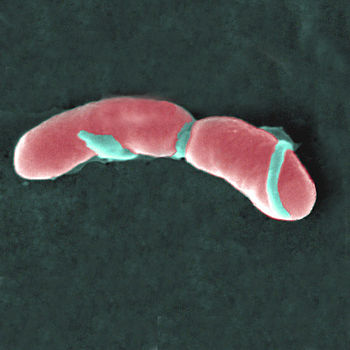Listeria monocytogenes
Articles that lack this notice, including many Eduzendium ones, welcome your collaboration! |
| Listeria monocytogenes | ||||||||||||||
|---|---|---|---|---|---|---|---|---|---|---|---|---|---|---|
 | ||||||||||||||
| Scientific classification | ||||||||||||||
| ||||||||||||||
| Binomial name | ||||||||||||||
| Listeria monocytogenes |
Description and significance
Listeria monocytogenes is a gram positive, rod shaped bacterium that is usually arranged in short chains. When smeared L. monocytogenes may be coccoid and mistaken for Streptococci and larger cells tend to resemble corynebacteria. Flagella are present at room temperature. Are motile due to flagella and can also use obtain motility by using the host cell actin filaments to move within and between cells. [1] The bacterium L. monocytogenesis nearly found everywhere in the environment and can be isolated from wild and domestic animals, birds, insects, soil, wastewater, and vegetation. L. monocytogenes are able to survive in a wide range of varying temperatures from below freezing to body temperature and typically grows best at 0 degrees Fahrenheit to 50 degrees Fahrenheit. In fact this very range of temperature is used for freezing and refrigeration! It is resistant to freezing, drying, and heat. Which is extremely well for a bacterium that does not form spores. [2]
L. monocytogenes is an intracellular pathogen that is the cause of the major food born infection Listeriosis. The disease is transmitted from the consumption of mainly contaminated dairy and meat products. L. monocytogenes is carried in the intestinal tract and 5-10% of the human population who carry no apparent symptoms of the disease. [3] The individuals that are highly susceptible to this disease are pregnant women, the elderly, and individuals with deficient immunity due to illness or medication. [4]
In the United States an estimated 2,500 persons become seriously ill with Listeriosis and 500 of these individuals die. [5]
Sequencing the genome of this deadly bacterium is vital as a basis for improving food safety and is one that is most highly researched. By using comparative analysis and gene arrays researchers are able to study the traits of evolution and new traits.
The bacterium Listeria monocytogenes is named after Joseph Lister who introduced sterilization to the realm of medicine. [6]
Since the 1960s the bacterium L.monocytogenes was thought to only cause infection in animals. It was first discovered ninety years ago in rabbits and pigs. It's lethal effects as a foodborne pathogen wasn't apparent until 1981 after a major outbreak. [7] However, it soon came to light that both animals and humans carry this disease and that it can be isolated from numerous sources in the environment.
Genome structure
Listeria Monocytogenes has two strains of sequences that have been sequenced. Several others are currently being sequenced. The size of these strains is 2.9 Mb and the percentage content of %GC is 37- 39%. [8]. The only two strains that have been sequenced are L. monocytogenes strain EGD-e (serotype 1/2a) and Listeria innocua CLIP 11262 (serotype 6a). The strand EGC-e is 2,944,523 base pairs long with 2,853 open reading frames and a %GC percent content of 39%.[9] One of the currently researched strands is F236 (serotype 4b, cheese isolate) and it is 2,905,187 base pairs long. The percent content of AT is 62.0%. The number of genes present in this strain is 2, 821 genes, 1,030 base pairs per gene.[10] About 50% of the sporadic Listeria infection outbreaks have been determined to be from the strain F236 serotype 4b.
Listeria monocytogenes has a single circular chromosome. The ability for Listeria Monocytogenes to be able to survive in a wide range of environments is made possible by the 331 genes encoding different transport proteins.
Cell structure and metabolism
Describe any interesting features and/or cell structures; how it gains energy; what important molecules it produces.
Ecology
Describe any interactions with other organisms (included eukaryotes), contributions to the environment, effect on environment, etc.
Pathology
Listeria Monocytogenes is an intracellular pathogen of both humans and animals. It is the cause of the food born infection Listeriosis. Outbreaks of the disease are found to be caused by consumption of contaminated milk, soft cheese, and meat products. Symptoms include gastrointestinal symptoms of vomiting and diarrhea as well as patient symptoms of influenza. Individuals that are more highly susceptible of acquiring the infection Listeriosis are pregnant women and people who are immune-suppressed due to illness or medication. For one, the reason that there is such an increased risk in pregnant women is that it may be related to both systematic and local immunological changes associated with pregnancy. In immune-suppressed individuals the invasion, intracellular multiplication, and cell to cell spread of bacterium appears to be mediated through proteins such as internalin, the hemolysin O, listeriolysin, and phospholipase C. Also bear in mind that since Listeria Monocytogenes is an intracellular pathogen it will affect immune-suppressed individuals more.
Unlike the several other food-borne pathogens which are the cause of gastrointestinal illness, L. monocytogenes is causes serious disease such as meningitis, sepsis, encephalitis, corneal ulcer, pneumonia, and stillbirth. The diagnosis of Listeria is by the culture of the bacterium. Also, the treatment method of this disease is intravenous administration of either ampicillin or penicillin.
However, it must be noted that L. monocytogenes is found to be part of the normal gastrointestinal microbiota in healthy individuals resulting in no symptoms. The effect of the pathogen depends not only on the individual but also the strain of bacterium.
Application to Biotechnology
Does this organism produce any useful compounds or enzymes? What are they and how are they used?
Current Research
Enter summaries of the most recent research here--at least three required
References
- ↑ "Listeria Monocytogenes." Wikipedia, The Free Encylopedia. 4 April 2008.[1]
- ↑ "A focus on Listeria Monocytogenes." USDA: National Agricultural Library. 4 April 2008. [2]
- ↑ "Listeria monocytogenes." Foodborne Pathogenic Microorganisms and Natural Toxins Handbook. U.S. Food and Drug Administration. 4 April 2008. [3]
- ↑ "Listeria monocytogenes and Listeriosis." Todar's Online Textbook of Bacteriology. 4 April 2008. [4]
- ↑ "Division of Foodborne, Bacterial and Mycotic Diseases (DFBMD). CDC. 4 April 2008. [5]
- ↑ "Listeria Monocytogenes." Wikipedia, The Free Encylopedia. 4 April 2008.[6]
- ↑ "A focus on Listeria Monocytogenes." USDA: National Agricultural Library. 4 April 2008. [7]
- ↑ Willey, Sherwood, and Woolverton. Prescott, Harley, and Klein’s Microbiology, Seventh Edition. McGraw-Hill Companies: New York, 2008. 386-387.
- ↑ "Listeria Monocytogenes." Mircobe Wiki. 4 April 2008. [8]
- ↑ Peter F. Hallin and David Ussery (2004). CBS Genome Atlas Database: A dynamic storage for bioinformatic results and sequence data Bioinformatics 20:3682-3686 PDF | Pubmed
1. "Listeria Monocytogenes." Wikipedia, The Free Encylopedia. 4 April 2008. [9]
2. "Listeria monocytogenes." Foodborne Pathogenic Microorganisms and Natural Toxins Handbook. U.S. Food and Drug Administration. 4 April 2008. [10]
3. "Division of Foodborne, Bacterial and Mycotic Diseases (DFBMD). CDC. 4 April 2008. [11]
4. "A focus on Listeria Monocytogenes." USDA: National Agricultural Library. 4 April 2008. [12]
5. "Incidence of Food Borne Illness 1996-2005: Listeria*." The Case of the Cold-Loving Microbe. 4 April 2008. [13]
6. "Listeria monocytogenes and Listeriosis." Todar's Online Textbook of Bacteriology. 4 April 2008. [14]
7. "Whole genome comparisons of serotype 4b and 1/2a strains of the food-borne pathogen Listeria monocytogenes reveal new insights into the core genome components of this species." Pubmed. 4 April 2008. [15]
8. Peter F. Hallin and David Ussery (2004). CBS Genome Atlas Database: A dynamic storage for bioinformatic results and sequence data Bioinformatics 20:3682-3686 PDF | Pubmed
9. "Listeria Monocytogenes." The Institute For Genomic Research. 4 April 2008. [16]
10. " Whole-Genome Sequence of Listeria welshimeri Reveals Common Steps in Genome Reduction with Listeria innocua as Compared to Listeria monocytogenes." Journal of Bacteriology, November 2006, p. 7405-7415, Vol. 188, No. 21. [17]
11.
